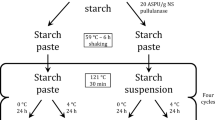Abstract
The effect of cooking (boiling) on the starch digestibility, polyphenol contents and in vitro α-amylase inhibitory properties of two varieties of cocoyam: Colocassia esculenta (taro) and Xanthosoma mafafa (Tania) were investigated. The total starch contents of the raw and cooked tubers ranged from 25.3 to 35.6 g 100 g−1; resistant starch ranged from 9.7 to 20.9 g 100 g−1; digestible starch ranged from 11.7 to 24.2 g 100 g−1. The starch digestibility of the raw and cooked tubers ranged from 35.89 to 71.38% while their rapidly digestible starch values (expressed as g 100 g−1 of total starch) ranged from 20 to 32 g 100 g−1. The raw tubers contained considerable amounts of phenols and flavonoids and boiling of the tubers retained their phenolic and flavonoid contents. The aqueous extracts of the raw and cooked tubers demonstrated considerable α-amylase inhibition properties (32.47–46.62% over a concentration range of 10–50 mg mL−1) under in vitro conditions but which were lower than that of the antidiabetic drug—acarbose that had 69.08% inhibition of alpha amylase activity over a range of concentration of 2–10 mg mL−1. The study showed that the raw and cooked forms of the cocoyam varieties had low digestibility of their starches and exerted considerable inhibition of α-amylase activity under in vitro conditions which suggests the potential usefulness of the boiled forms of these cocoyam varieties as functional foods for people with type 2 diabetes mellitus.



Similar content being viewed by others
References
A. Barcelo, C. Aedo, S. Rajpathak, S. Robles, Bull. World Health Org. 81, 44 (2003)
American Diabetes Association, Diabetes Care 34, S62–S69 (2011)
International Diabetes Federation, IDF Diabetes Atlas, 7th edn (Brussels: International Diabetes Federation, 2015). http://www.diabetesatlas.org
C.O. Eleazu, Afr. Health Sci. 16, 468–479 (2016)
C. Eleazu, I. Ezekwibe, M. Egbe, S. Saidu, K. Eleazu, C. Egedigwe, Acta Sci. Pol. Technol. Aliment 16, 93–99 (2017)
B. Elya, R. Handayani, R. Sauriasari, A. Azizahwati, U.S. Hasyyati, I.T. Permana, Y.I. Permatasari, Pak. J. Biol. Sci 18, 279–284 (2015)
A.G. Kirsty, S. Samir, G.F. Catherine, J.G. Patricia, K.J. Stuart, J.Q. Kenneth, J. Sci. Food Agric. 88, 652–658 (2008)
C.O. Eleazu, K.C. Eleazu, M.A. Iroaganachi, W. Kalu, J. Food Biochem. 41, e12355 (2017)
L.L. Niba, Int. J. Food Sci. Nutr. 54, 97–109 (2003)
A. Chatterjee, S.C. Pakrashi, The Treatise on Indian Medicinal Plants, vol. 5 (New Delhi: National Institute of Science Communication, 1997), pp. 99–100
O.L. Mwenye, M.T. Herselman, L. Benesi, F.P. Chipungu, in Second RUFORUM Biennial Conference Meeting Entebbe, Uganda (2010), pp. 193–199
K.R. Kirtikar, B.D. Basu, Indian Medicinal Plants (Dehradun: Oriental Enterprises, 2011), pp. 3598–3602
S. Simsek, S.N. El, Carbohydr. Polym. 90, 1204–1209 (2012)
E.J. Rodríguez-Sosa, M. Gonsález, J. Agric. Univ. Puerto Rico 61, 26–31 (1977)
C.O. Eleazu, P.N. Okafor, I.I. Ijeh, Asian Pac. J. Trop. Dis. 4, S705–S711 (2014)
K. Iwai, Plant Foods Hum. Nutr. 63, 163 (2008)
I. Goni, A. Garcia-Alonso, F. Saura-Calixto, Nutr. Res. 17, 427–437 (1997)
P.M. Rosin, F.M. Lajolo, E.W. Menezes, J. Food Compos. Anal. 15, 367–377 (2002)
L. Sęczyk, M. Świeca, D. Dziki, A. Anders, U. Gawlik-Dziki, Food Chem. 214, 32–38 (2017)
C.O. Eleazu, K.C. Eleazu, M. Iroaganachi, Innov. Food Sci. Emerg. Technol. 37, 37–43 (2016)
M. Segura, C.M. Rosell, Plant Foods Hum. Nutr. 66, 224–230 (2011)
S. Hedieh, N. Marjan, A. Gholamreza, S. Parisa, R.G. Ahmad, K. Mahdieh, S. Soodabeh, J. Diabetes Metab. Disord. 13, 114 (2014)
H. Ali, P. Houghton, A. Soumyanath, J. Ethnopharmacol. 107, 449–455 (2006)
V.L. Singleton, R. Orthofer, R.M. Lamuela-Raventos, Methods Enzymol. 299, 152–178 (1999)
A.A.L. Ordonez, J.D. Gomez, M.A. Vattuone, M.I. Isla, Food Chem. 97, 452–458 (2006)
M. Piecyk, R. Wołosiak, B. Drużynska, E. Worobiej, Food Chem. 135, 1057–1064 (2012)
V.D. Capriles, K.D. Coelho, A.C. Guerra-Matias, J.A.G. Areas, J. Food Sci. 73, H160–H164 (2008)
M.G. Sajilata, R.S. Singhal, P.R. Kulkarni, Compr. Rev. Food Sci. Food Saf. 5, 1–17 (2006)
M. Frei, P. Siddhuraju, K. Becker, Food Chem. 83, 395–402 (2003)
H. Chung, D. Shin, S. Lim, Food Res. Int. 41, 579–585 (2008)
H.N. Englyst, G.J. Hudson, Food Chem. 57, 15–21 (1996)
H. Laoufi, N. Benariba, S. Adjdir, R. Djaziri, J. Appl. Pharm. Sci. 7, 191–198 (2017)
N. Uddin, R. Hasan, M. Hossain, A. Sarker, N. Hasan, M. Islam, M.H. Chowdhury, S. Rana, Asian Pac. J. Trop. Biomed. 4, 473–479 (2014)
Acknowledgements
The authors wish to thank the technical staff of the Department of Chemistry/Biochemistry, Federal University Ndufu-Alike, Ikwo, Ebonyi State, Nigeria for their assistance.
Author information
Authors and Affiliations
Corresponding author
Ethics declarations
Conflict of interest
The authors declare no conflict of interest.
Rights and permissions
About this article
Cite this article
Eleazu, C., Sampson, A., Saidu, S. et al. Starch digestibility, polyphenol contents and in vitro alpha amylase inhibitory properties of two varieties of cocoyam (Colocassia esculenta and Xanthosoma mafafa) as affected by cooking. Food Measure 12, 1047–1053 (2018). https://doi.org/10.1007/s11694-018-9720-9
Received:
Accepted:
Published:
Issue Date:
DOI: https://doi.org/10.1007/s11694-018-9720-9




